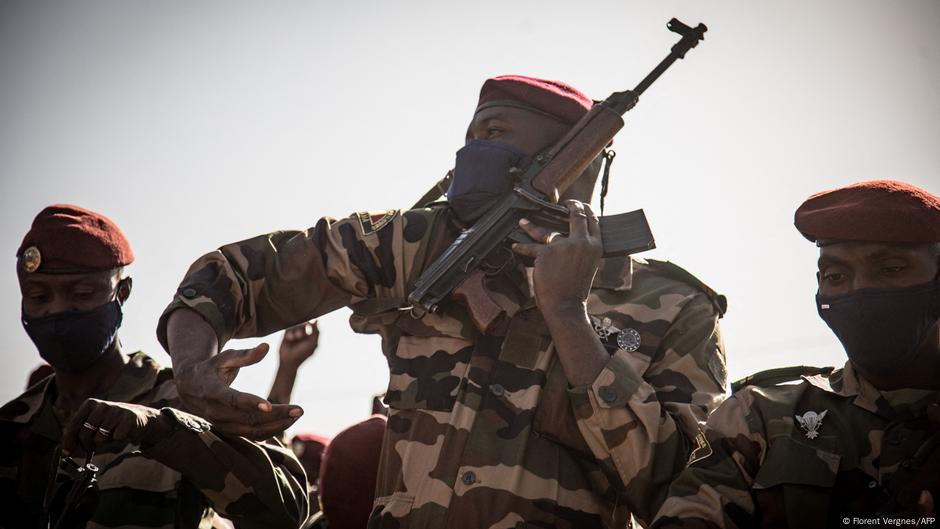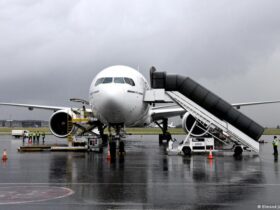It is said that a picture is worth a thousand words; A photo posted on Telegram in December 2024 proves how accurate that expression really is.
The image in question shows a pair of feet resting in shadow on a red carpet in the middle of the desert with a pack of cigarettes in the foreground – almost like an artistic postcard of the Sahel.
But upon closer inspection, there is much more to this photo: on the right is a Malian army ration and perhaps even more surprisingly, in the background is a parked 4×4 pickup truck with a machine gun mounted on the back.
The photo was posted on a channel officially linked to the defunct Russian private military company Wagner, and the legs seen in the foreground appear to be those of a mercenary.
the devil is hidden in the details
A closer look reveals that the truck is similar to those used by Mali’s national army. The weapon mounted on the back of the truck is a W85 heavy machine gun manufactured by Chinese arms company NORINCO.
This is an important detail, as both China and Mali are part of the 2013 UN-brokered Arms Trade Treaty (ATT), which commits arms exporters and importers to far-reaching due diligence obligations.
ATT Signatory states are required to ensure that arms exports do not contribute to human rights violations, war crimes or destabilization of regions.
But what does that treaty have to do with this image?
If it were proven that the Malian army had provided equipment to Russian mercenaries, it would be considered a clear violation of the ATT agreement.
Any such potential violation of the ATT would mean that Mali could face diplomatic consequences and sanctions if suspicions of diverting weapons from their intended end users were confirmed.
New study says Wagner uses Malian military equipment
Global Initiative Against Transnational Organized Crime (GI-TOC) Turns out that Russia-linked mercenaries have relied heavily on Malian military material and equipment, even in the absence of Malian troops during operations.
This includes the use of armored vehicles, machine guns mounted on light 4x4s, and even attack drones.
GI-TOC analyst Julia Stanyard told DW that investigators “found that the Wagner Group was systematically using military goods and equipment that were intended for the Malian armed forces during its deployment in Mali.”
Stanyard explained that the research team came to this conclusion after interviewing anonymous sources within the Malian armed forces and corroborating their answers with evidence such as photographs of armored vehicles and other military equipment on Telegram channels, as well as other open source resources.
The GI-TOC report strongly accuses Mali’s military leadership of knowingly allowing Russian mercenaries to seize such military equipment.
UN report: Wagner broke rules in CAR too
The GI-TOC report specifically named five types of armored vehicles that were identified by Wagner: two from the United Arab Emirates, and one each from China, France, and Nigeria. This is in addition to machine guns from China and drones from Türkiye.
All states except the UAE are direct signatories to the ATT; In the case of the United Arab Emirates, there are national laws that require so-called end-use certificates, which stipulate that the receiving country will not remove received military equipment without authorization.
However, there is additional evidence pointing to the fact that arming Wagner mercenaries did not always conform to such regulations, such as 2021 united nations report On the Central African Republic (CAR).
The authors of that document found that Wagner troops had diverted weapons supplied by Russia to their own use, even though only CAR troops were authorized to use them.
The United Nations considered this a violation of end user controls.
Wagner mercenaries: new jobs in Russia’s Africa Corps
Initial reports of Wagner troops being deployed to Mali first emerged in late 2021; Following two consecutive military coups, Mali’s new junta rulers ended the country’s long-standing security cooperation with Western forces, particularly France but also Germany.
Mercenaries from Russia were brought in to fill the void and support the overstretched Malian army in combating terrorists and rebels.
However, numerous human rights violations were recorded during this period.
In 2023, Wagner leaders are at odds with Russian President Vladimir Putin’s regime in Moscow, resulting in a failed rebellion against the autocratic leader and the death of Wagner chief Yevgeny Prigozhin under extremely mysterious circumstances.
Wagner, which was active in several African countries, was largely disbanded, with its units placed under the command of the newly established Africa Corps, a part of Russia’s Defense Ministry.
In June 2025, the Wagner Group’s mission in Mali also officially ended, with the Africa Corps replacing it.
Wagner and Afrika Korps are two sides of the same coin
The evidence collected in the GI-TOC study relates only to the activities of the Wagner Group.
However, there are indications that Africa Corps has been operating in a similar manner since then, Stanyard said.
“It’s often made up of many of the same people. A lot of the guys deployed with the Africa Corps in Mali are former Wagner mercenaries. So, although they’re obviously a different organization, in some ways they’re very much alike.
He said, “I think the changes to Africa Corps do not mean greater adherence to international norms on the part of the Russian state. In fact, it is quite the opposite.”
Traces of Ukraine were in Africa
Irina Filatova, a Russian historian living in South Africa, said Wagner has received arms deliveries from Russia for its deployment since its inception in the mid-2010s. However, in Mali’s case, he told DW that he had no knowledge of such deliveries.
He stressed, “With the war in Ukraine dragging on and Russia’s resources being depleted, it would be logical to use what is available, especially since both Wagner and Afrika Korps train local people.”
Despite DW’s multiple requests for comment, members of Mali’s transitional parliament either rejected the report’s findings or did not respond by the time of this article’s publication.
Kosivi Tiasou contributed to this article.
Edited by: Serton Sanderson






Leave a Reply